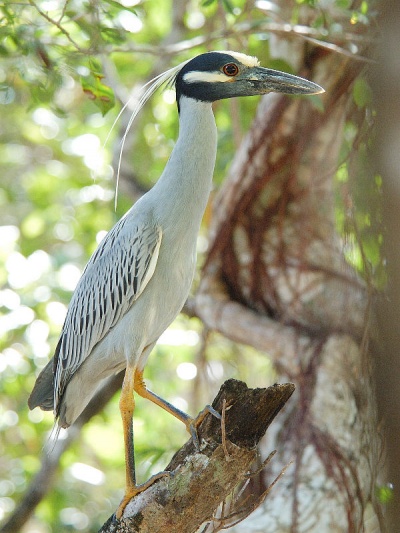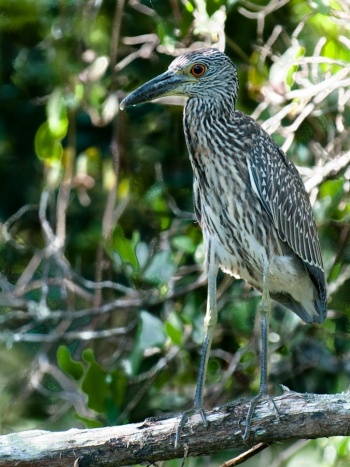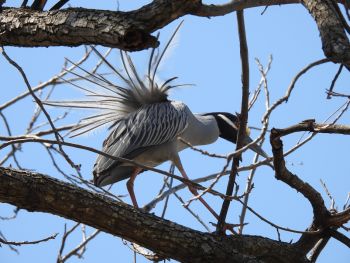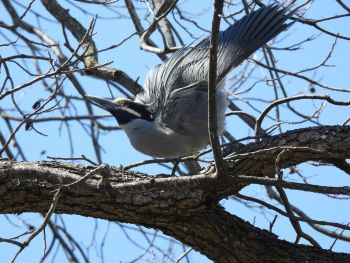- Nyctanassa violacea
Identification
51–70 cm (51-27½ in)
Grey body, Pale yellow crown, red eyes and short yellow legs, white stripe below the eye completely surrounded by black. Black feather centers produce a pattern on the wings. The bill has a specific shape, with the culmen tapering down and the mandible tapering up to the tip of the bill so that the bill overall is shaped like a chisel.
Juveniles are mainly brown flecked with white or gray. They have yellow eyes; immatures have orange eyes.
Flight
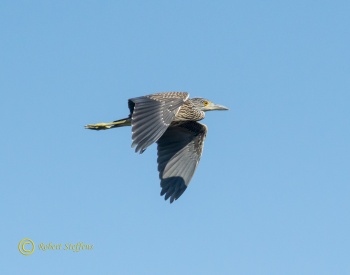
Photo © by STEFFRO1
Huntington Beach State Park, South Carolina, 18 July 2014
In flight will have strong legs protruding back beyond the short tail and the neck held in a compact S shape.
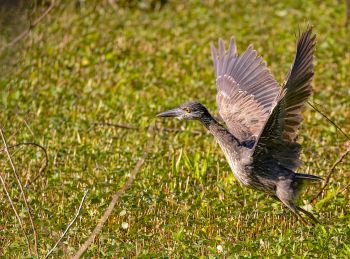
Photo © by Stanley Jones
Brazos Bend State Park, Fort Bend County, Texas, USA, 20 April 2021
Similar species
Black-crowned Night Heron and Boat-billed Heron are the most similar to both adults and juveniles, and the juvenile additionally has some similarities to American Bittern. Notice the shape of the bill of the Black-crowned Night-Heron which has lower edge of the mandible straight.
Immatures and especially juveniles differ from Black-crowned Night Heron as follows:
- tiny pale spots on the wings and narrow white edges to the greater coverts (as compared with more extensive streaks in Black-crowned)
- duller brown with smaller pale teardrop marks
- relatively well-defined dark longitudinal neck streaks (especially juveniles)
- thicker, all-black and deep-based bill with a blunt tip. This may have a yellowish base to the lower mandible but it is never as extensive as in Black-crowned
- lower mandible generally curves up to meet upper mandible. In Black-crowned the lower mandible is much straighter
- longer-legged: usually can see more leg above the "knee" than in Black-crowned
Distribution
North, Central and South America and the Caribbean.
North America: limited to eastern parts where breeding coastally from Maine to Florida and the along the Gulf Coast and inland from the Great Lakes to Colorado and Texas. Recently expanded to Southern California breeding north to Ventura County [5].
Central America: Range continues along Gulf Coast of Mexico and along the Atlantic side south to Panama and also occurs along the Pacific coast from Baja California southwards.
South America: occurs in coastal areas from Colombia to Rio Grande do Sul, Brazil in the east, as well as south to northern Peru in the west and on the Galapagos Islands.
The Caribbean: Also occurs throughout the West Indies and has been reintroduced to Bermuda.
Most northern birds move southwards after breeding to winter in the southern USA, Mexico, Central America and the West Indies. Vagrants recorded north to Nova Scotia and Newfoundland.
Taxonomy
Subspecies
Clements recognises the following subspecies [1]:
- N. v. violacea: Central and eastern US to east Mexico and Honduras
- N. v. bancrofti: Baja California and west Mexico to El Salvador and West Indies. [paler and larger-billed]
- N. v. gravirostris: Socorro Island (of the Revillagigedo Islands off western Mexico). [Large-billed]
- N. v. caliginis: Panama to Peru. [Large bill and darker grey upperparts]
- N. v. cayennensis: Colombia to east Brazil. [Slender-billed with dark upperparts]
- N. v. pauper: Galapagos Islands. [small and dark]
Habitat
Mainly coastal areas including rocky shores, mudflats and mangroves. Also inland on lakeshores and riverbanks. Breeding in swamps and marshes.
Behaviour
The degree to which they are active during day or dawn/dusk varies both geographically and with time of year; they are more likely to be encountered before dark when they have young in the nest.
Breeding
Mainly colonial nesters in trees or shrubs. The platform nest is built of sticks near water. The clutch consists of 3–5 pale blue-green eggs.
Diet
The diet includes crustaceans, molluscs, frogs, aquatic insects and small fish, but one favorite food is land crabs; their bills are shaped like chisels and used to hammer a hole in the back of the crab shell.
Vocalisations
Commonest call is "Scaup" similar to "Quock" Call of Black-crowned Night-Heron but higher pitched.
References
- Clements, J. F., T. S. Schulenberg, M. J. Iliff, D. Roberson, T. A. Fredericks, B. L. Sullivan, and C. L. Wood. 2018. The eBird/Clements checklist of birds of the world: v2018. Downloaded from http://www.birds.cornell.edu/clementschecklist/download/
- Birdforum member personal observations
- Watts, B. D. (2020). Yellow-crowned Night-Heron (Nyctanassa violacea), version 1.0. In Birds of the World (A. F. Poole, Editor). Cornell Lab of Ornithology, Ithaca, NY, USA. https://doi.org/10.2173/bow.ycnher.01
- Wikipedia contributors. (2018, September 4). Yellow-crowned night heron. In Wikipedia, The Free Encyclopedia. Retrieved 10:19, October 17, 2018, from https://en.wikipedia.org/w/index.php?title=Yellow-crowned_night_heron&oldid=858077943
- Lehman, P. E. "The Birds of Santa Barbara County, California", Revised edition, July 2018, available at https://sites.google.com/site/lehmanbosbc/, 2018. Original edition: The Vertebrate Museum, University of California, Santa Barbara, 1994.
- Watts, B. D. (2011). Yellow-crowned Night-Heron (Nyctanassa violacea), version 2.0. In The Birds of North America (A. F. Poole, Editor). Cornell Lab of Ornithology, Ithaca, NY, USA. https://doi.org/10.2173/bna.161
Recommended Citation
- BirdForum Opus contributors. (2024) Yellow-crowned Night Heron. In: BirdForum, the forum for wild birds and birding. Retrieved 25 April 2024 from https://www.birdforum.net/opus/Yellow-crowned_Night_Heron
External Links
GSearch checked for 2020 platform.1




